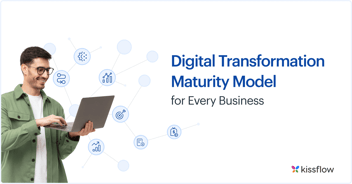Related Articles

6 MINUTES READ
Innovation’s Role in Digital Transformation
6 MINUTES READ
Digital Transformation Plan/initiatives
Team Kissflow
Updated on 16 Apr 2025 • 6 min read
In recent years, organizations across different industries have been leveraging digital advancements to improve their performance and reach radically. This is what digital transformation is all about. It involves using traditional and advanced technological business components to change how businesses handle internal processes, value delivery, and customer relationships.
Seeing how fast digital technology has disrupted business-as-usual for their competitors, business leaders are learning to pay more attention to the trend. Regardless of size, any organization serious about implementing a digital transformation strategy must first understand the components of this trend and what they can achieve with it.
Many large companies have invested substantially in what they consider “digital transformation” without realizing any clear returns in benefits. One of the common causes for such failures is a lack of understanding of the components and capabilities of digital transformation before embarking on a transformation agenda.
This post details all the basics you need to know about the components and capabilities of digital transformation for your organization.
Transforming a business digitally is a complex undertaking that often involves various factors. Many people erroneously assume it’s about investing in fancy tech tools or jumping on the next digital trend. This naive assumption is one of the leading causes of failures of digital transformation efforts.
While technology is obviously a massive part of digital transformation, it entails other components, too, as detailed below:
Expectedly, technology lies at the centre of every digital transformation drive. While there are other essential components to consider, it is ultimately about merging modern technologies with your internal processes. This allows businesses to stay ahead of the curve and offer innovative products and services to customers.
Identifying fitting digital tools for your business is one of the most vital components of a digital transformation strategy. Implementing modern technologies for your company requires significant financial investment, and it must be done correctly to ensure optimal return on investment.
Therefore, the technological aspect of digital transformation is not an unreasonable search for the next fancy or trendy digital tools. Whether you’re trying to update legacy systems or implement an entirely new digital infrastructure for your organization, the goal should always be to find the most appropriate technologies to drive the intended results.
For most organizations, enabling new technology goes hand-in-hand with internal process redesign. Technology should be implemented for its own sake and to improve operational efficiency in the long run.
The people component is arguably the most critical component of any digital transformation drive. In fact, it is impossible to achieve a full-scale technology transformation with all the budget and technical capabilities in the world if the human component is not incorporated into your strategy.
That’s because digital transformation is all about people. That includes the humans at the other end of your digital transformation efforts (your customers) and the people involved in making it happen (your employees).
Digital transformation often comes with a massive culture shift. It’s an inevitable consequence of any serious drive for digital change. The effectiveness of this culture change is a key cornerstone of a successful digital transformation drive.
Therefore, it will be helpful if the people involved with achieving this change fully understand what is required and are on board with your plans. Their willingness to align with whatever new initiative you intend to implement will determine how well you can pull it off at the end of the day.
Digital transformation is not “directionless.” Vision is the key distinction between merely adopting new geeky technology for its sake of it and truly transforming your business. To lead digital change, managers must have a vision of how they intend to transform their company in the business world that’s becoming rapidly digitized.
Fitting technologies in the hands of the right people is all you need to digitize or digitalize your business. But what makes it an actual “digital transformation” is how you direct and guide these components. Hence, a strategy based on a clear vision is the most crucial component of any digital transformation drive.
A clear and well-thought-vision can lead to a smoother, more timely, and more cost-effective digital transformation. All your effort must be directed based on your specific business goals and vision of how you want to transform your company.
Maintaining a clear goal for your digital transformation effort is the North stay that keeps the strategy going. It is also the yardstick against which you measure the efforts of all your efforts in the long run.
Customers want what they want. This is one of the realities of the 21st-century business ecosystem. Since one of the core goals of digital transformation is to reimagine your entire business model in order to improve customer experience, knowing what your customers want and how best to serve them is one of the core components of digital transformation. You’ll need data to fully understand this and implement digital transformation in alignment with customer needs.
Data analysis has to be built into your digital transformation strategy. Analyzing data will help you understand your customer's pain points, know your team's capabilities, and measure the outcomes of the different stages of your digital transformation strategy.
Data will also help with better decision-making as it helps you identify the solutions that guarantee the best outcomes. You need easily accessible records of your organization's interactions with customers, employees, and clients to plan an effective digital transformation strategy.
Figuring out these components is only one part of the story. The highlight of digital transformation is what you can achieve with it. Integrating digital technology into all areas of your business promises a shift in how your business operates and delivers value to your customers.
Understanding digital transformation capabilities will help you define your expectations and goals from the process so you can tweak outcomes expectedly to align with your business goals.
Launching the right tools for work can help improve productivity within an organization. This is one of the lofty goals organizations should aspire to when they think of digital transformation and what it can do for them.
From operational dashboards to handling processes, employee portals, or customer-facing applications, designing and building tailor-made apps that suit your needs is one of the ways you can streamline workflows and innovate rapidly.
These days, app building as part of a digital transformation effort is even faster thanks to no-code and low-code platforms. No-code enable business users to build apps that suit their needs to optimize internally without waiting for traditional developers.
App building through a citizen development program also helps fast-track digital transformation as it engages employees better and makes achieving the required cultural change easier.
Digital transformation hardly ever starts from zero. That’s because most organizations are already at a specific point in digitizing or digitalizing their business processes even before they become aware of what digital transformation is or make plans to implement it. From spreadsheets to email communications, most businesses already make use of one digital tool or the other.
In most cases, you can leverage what you already have by integrating new tools with the existing system. Digital transformation often involves tying all the digital tools you already use together and aligning them with your digital transformation goals. By leveraging simple connectors and triggers, you can expand your tech stack to include existing tools while incorporating new ones.
Every business has numerous operations and processes that could use automation and workflow improvements. Think of all the tasks you wish you could do faster, simpler, and more effectively. Digital transformation can help you optimize these processes for better outcomes.
One of the core goals of digital transformation is to make workflows smoother and easier. You can leverage digital technologies to automate mundane tasks and speed up operations.
Automation also improves effectiveness and reduces the possibility of human errors getting in the way of business outcomes. Improving processes mean different things for different organizations. In banks, the process improvement goals of digital transformation may be in terms of simplifying KYC or automating compliance checks, while for a hospital, it may be to improve end-to-end documentation of patients.
Digital transformation can promote a digital culture that makes it easier for employees to work together. The right digital tools can improve how tasks are delegated and managed within teams. Companies with winning digital transformation strategies can achieve significant strides in handling day-to-day tasks and collaborating using team channels, chat tools, task dashboards, and other tools that foster efficiency and communication.
Up to 80 percent of organizations that have completed digital transformation report a significant increase in their profit. Digital transformation drives business success in different ways, but ultimately it impacts the bottom line positively. Increased ROI is one of the many positive consequences of meeting customer needs with better precision, working more productively, and improving the overall efficiency of business processes.
Digital transformation is about redefining how companies operate, and Kissflow offers all the tools and features to help accelerate this process. From automating standard workflows to improving internal processes using a nimble cloud-based work platform, Kissflow helps organizations of all sizes fast-track digital transformation.
Kissflow takes a low-code approach to handle the technology component of digital transformation. This approach solves multiple problems associated with the other components of digital transformation. It enables citizen development-activating an army of tech-savvy business users who can drive large-scale digital transformation for your organization within a short time.
Start reimagining your business processes and building smarter solutions that drive better business outcomes with Kissflow's Digital transformation platform.
Related Articles


Welcome.
Let's get started.
To begin, tell us a bit about yourself
By proceeding, you agree to our Terms of Service and Privacy Policy
"The beauty of Kissflow is how quick and easy it is to create the apps I need. It's so user-friendly that I made exactly what I needed in 30 minutes."
Oliver Umehara
IT Manager - SoftBank
A Trusted Choice for Companies Globally




Thank you for signing up
Someone from our team will contact you soon.

Know why all the IT leaders converging at booth #602
Earn a chance to be part of our experience event

Get the first look at the 2024 Citizen Development report
Welcome.
Let's get started.
By proceeding, you agree to our Terms of Service and Privacy Policy
Wondering where to start?
Let's talk!
Connect with our solution experts to gain insights on how Kissflow can help you transform ideas into reality and accelerate digital transformation

This website uses cookies to ensure you get the best experience. Check our Privacy Policy
